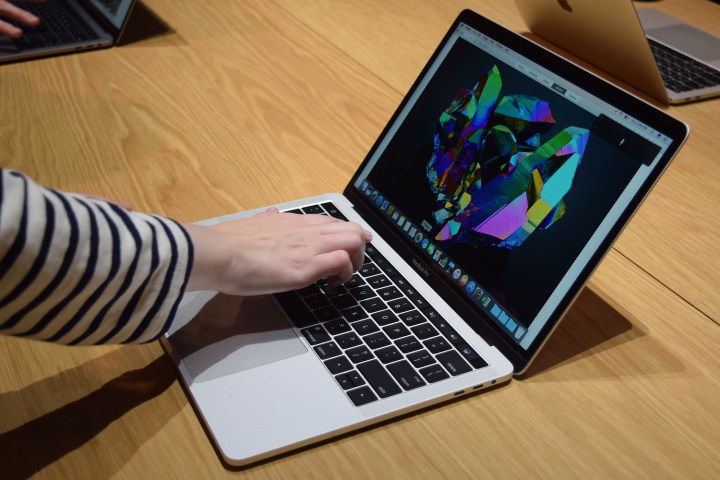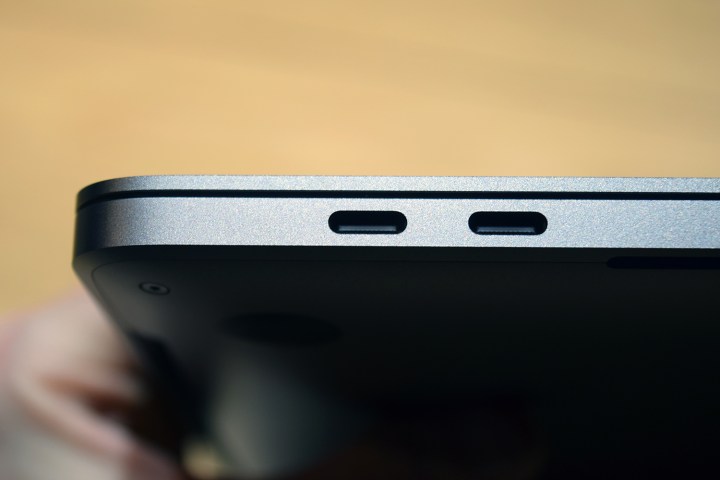Apple’s new OLED Touch Bar will make you want to touch every part of the Macbook Pro.
It’s been four long years since Apple released a new MacBook Pro. Finally, there are three new Pro models on the market, two of which sport a brand-new OLED Touch Bar with Touch ID support for added security and mobile payments.
We peeked at the 15-inch MacBook Pro with Touch Bar to find out if it’s the update Mac fanatics have eagerly been waiting for.
Slimmed down design with flatter keys
The new MacBook Pro line is much slimmer and lighter than previous Pro models. The 15-inch laptop is 15.5mm thin, making it slimmer than the thickest point of the 13-inch MacBook Air. It’s still not as slim as some Windows laptops, but it’s a big difference for current MacBook Pro users. The new 15-inch Pro weighs in at four pounds, while the 13-inch model weighs 3 pounds – the same as the 13-inch MacBook AIr.
The screen is much slimmer than it is on previous MacBook models, and the Apple logo no longer lights up. That’s to conserve space, of course, and the new logo is polished to a shine, just like it is on the iPhone and iPad. The screen looks bright and luminous, the color gamut has been improved, and the brightness is way higher. In fact, it’s almost doubled, jumping up to 500 nits.
If you’re looking for all your favorite ports on this MacBook Pro, you’re going to be disappointed. You only get four USB Type- C ports with Thunderbolt 3 support; two on each side. There’s no SD crad slot, no Ethernet, and no USB Type-A ports. There is, however, a headphone jack (yay!), and you do get four ports instead of just the one like you had on the 12-inch MacBook.
Apple has increased the size of the Force Touch trackpad, and it looks enormous on the 15-inch model. You have a lot of room to roam on that trackpad and Force Touch works well.
The backlit keyboard is an updated version of the flat keyboard we saw on the 12-inch MacBook. It has a bit more travel now, though, and you can feel the keys depress ever so slightly more. If you’ve ever used the MacBook, you probably thought it felt stiff. The keys feel better on the new Macbook Pro models, but they certainly do travel less than on the previous Pro model. That leaves us a bit concerned, as keyboard quality was our biggest beef with the 12-inch MacBook.
The Touch Bar is about more than just touch
The star of the show is clearly the Touch Bar. It changes every time you jump into another app to give you customizable tools that you can use with your fingers. If you go to Finder and then View, you can customize the Touch Bar. To add functions and tools, you simply drag them down toward the Touch Bar. The Touch Bar also shows you all the function keys that have been removed and gives you quick access to Siri.
In Messages, the Touch Bar gives you autocorrect suggestions, and it will even bring up emoji that you use a lot. Autocorrect may be the bane of your existence, or it may save you from a boatload of typos. We’ll have to see how helpful it is in everyday use, but it certainly looked great at a glance.
The new MacBook Pro goes a long way toward rehabilitating Apple’s reputation among computer geeks.
Every time I used the Touch Bar, it felt like using an iPhone. it was super-fast, smooth, and responsive. The tools presented in each app were useful, and a lot of them are clearly inspired by iOS. When you go into Photos, you can scroll through thumbnails on the Touch Bar just like you can on the iPhone. You get the same editing options and slider bars for tweaking your photos. Anyone who owns an iPhone will feel right at home with the Touch Bar.
We’re excited to see more third-party apps tap into the Touch bar’s potential, and Apple told Digital Trends that it’s had a lot of interest already. Key partners like Adobe and Microsoft are already onboard. We didn’t get to test those apps out today, but the keynote highlighted how those two companies are using the new Touch Bar interface.
It could be slightly wider to accommodate bigger text, tools, thumbnails, and sliders. When browsing photos, for example, the thumbnails displayed aren’t useful as a preview. Then again, you don’t need to see the thumbnails, since all the action takes place on the big screen.
Touch is simply a more natural way of interacting with apps. That’s why phones and tablets are so popular. It’s also why Windows went with touch, and there we found what might be the biggest problem with the Touch Bar. We often tried to touch the screen after using it. The instinct to do so is a natural urge, and it suddenly feels strange that the MacBook Pro’s screen is unresponsive when pressed.
There’s more to the Touch Bar than touch input, though. It also houses the first fingerprint sensor on a MacBook. Yes, the MacBook Pro has Touch ID with Apple Pay onboard. Online shopping has never been easier. You can visit your favorite store’s website on Safari, and if they have Apple Pay integrated, you simply select, “Apple Pay” at checkout, and you’ll be prompted to press your finger to the sensor to buy your items. It’s as easy and seamless as it is on the iPhone. And that’s not all the Touch ID sensor can do.
Just like on the iPhone, Touch ID lets you log into your MacBook Pro. You can set different people’s fingerprints to different accounts on the Pro, so each time you want to log in, you simply touch your finger and you’re into your account. No more passwords. This is great on a shared computer at home, but it’ll also be a good one for business travelers who want to keep their devices safe.
Finally! 6th Gen Intel chips and more power hit the Macbook Pro
Both the 13-inch and 15-inch MacBook Pro models received a modest internal refresh with sixth-generation “Skylake” Core i5 and i7 processors inside (dual-core on the 13-inch, quad-core on the 15-inch).
Every time I used the Touch Bar, it felt like using an iPhone.
As in the past, Apple has opted for Intel chips that are a bit different from those most common in Windows laptops. The 13-inch MacBook Pro without Touch Bar is standard with Intel’s Core i5-6360U, which can boost up to 3.1GHz. Upgrade to the 13-inch MacBook Pro with Touch Bar and you’ll get the Core i5-6267U, with a boost clock of up to 3.3GHz. In addition to that, the Core i5-6267U has a higher thermal design power than most mobile Intel dual-core chips – up to 28 watts, from the more typical 15 watts. This means the Core i5-6267U can draw in more juice to provide better performance. In the past, this has given the smaller MacBook Pro a bit of an edge over Intel
Also, both 13-inch models use Intel Iris graphics. That’s why Apple picked the 6th-gen Intel dual-core rather than the newer 7th-gen. Intel hasn’t released 7th-gen Core with Iris graphics yet.
The 15-inch MacBook Pro we looked at comes standard with an Intel Core i7-6700HQ, which isn’t a particularly new chip. Intel hasn’t released 7th-generation quad-cores, either, so they are missing in action. Apple has packed in cutting-edge graphics, though, in the form of AMD’s Radeon 450 Pro with up to 2GB of memory. This is upgradable to a Radeon Pro 455 with 2GB of memory, or a Radeon Pro 460 with 4GB memory. All these solutions use AMD’s new “Polaris” architecture. It’s hard to say how fast these solutions are, because this hardware is new to laptops, but it’s sure to be a big improvement over the ancient Radeon R9 M370X available before.
Both new Pros boast increased storage space, up to 2TB, with up to 16GB of RAM. Apple says the storage can hit transfer rates up to 3.1 gigabytes per second which, if correct, will certainly be at the bleeding edge of laptop performance.
In our short time with the new MacBook Pro, we found them to be fast, and were impressed with the complete lack of lag when going from Sleep to Wake mode. The MacBook wakes up so quickly, we never saw the screen change. Obviously, we were unable to fully test the new Pros with games or other processor-intensive apps, so we’ll hold off on pronouncing a verdict on speed or performance at this point.
Apple says the battery on all new MacBook Pro models should last about 10 hours. That’s one area Apple hasn’t improved. In fact, the new, slimmer MacBook Pro models have much smaller batteries than before. The 13-inch MacBook Pro with Touch Bar is down to 74.9 watt-hours to 49.2 watt-hours, while the 15-inch MacBook Pro with Touch Bar is down from 99.5 watt-hours to 74 watt-hours. Apple clearly hopes its new, more efficient internals will offset this substantial decrease in raw capacity.
Conclusion
The new MacBook Pros won’t come cheap. The non-Touch Bar 13-inch model costs $1,500 and up, the 13-inch with the Touch Bar costs $1,800 and up, and the 15-inch Touch Bar models starts at $2,400.
We think the new MacBook Pro goes a long way toward rehabilitating Apple’s reputation among computer geeks. Still, the company will need to update its MacBook more frequently to keep up with user demand and the changing market. Windows has snuck right in there and Microsoft’s partners are making slim, stylish laptops that are thinner, lighter, and sometimes more powerful than the MacBook lineup.
However, Apple still has some tricks up its sleeves and a loyal MacOS fan base that’ll be very pleased with the new MacBook Pro models. The Touch Bar is ingenious and very intriguing. If Apple and its developer partners can successfully integrate the Touch Bar into your Mac workflow, it could become the killer feature every Mac fan craves.
Highs
- A slimmer, lighter design
- Touch Bar is genius
- Touch ID adds security
- Apple Pay work great
- Giant trackpad
Lows
- Keyboard may be divisive
- Still lacks a touchscreen
- Much smaller battery than before
Editors' Recommendations
- The XPS 16 is fighting an uphill battle against the MacBook Pro
- MacBook Pro 16 vs. MacBook Pro 14: The important differences
- Best refurbished MacBook deals: Get a MacBook Air for $140 and more
- Best MacBook deals: Get an Air for $605 and save on M3 MacBook Pro
- Best Apple deals: Save on AirPods, Apple Watch, iPad, MacBook








